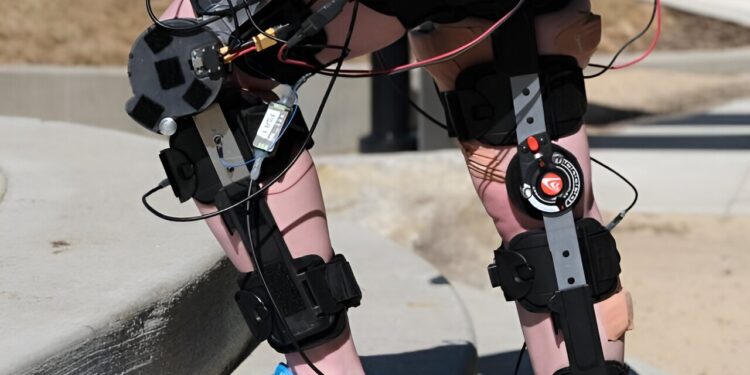Emily Keller, a robotics PhD student in the University of Michigan’s Locomotor Control Systems Laboratory, demonstrates knee exoskeletons on the steps outside the University of Michigan’s Ford Robotics Building. Credit: José Montes-Pérez, Robotics, University of Michigan
A set of knee exoskeletons built from commercially available knee braces and drone motors at the University of Michigan proved effective in combating fatigue during lifting and carrying tasks. They helped users maintain better lifting posture even when fatigued, a key factor in defending against workplace injuries, say researchers in a new paper published in the journal Scientific robotics.
“Rather than strengthening the back directly and giving up good lifting posture, we strengthen the legs to maintain that posture,” says Robert Gregg, a U-M robotics professor and corresponding author of the study. “This is different from what is more commonly done in industry.”
Workers who regularly lift, such as in construction and manufacturing, may already use back braces. Back exoskeletons, which use springs or motors to assist with lifting, are an emerging technology. But back-supporting devices involve dangerous lifting or bending, and back exoskeletons tend to be bulky devices that must be disabled to allow movements that aren’t part of the lifting task, Gregg said.
The Michigan team says their knee exoskeletons are the first to support the quadriceps muscles, which provide most of the strength needed to safely lift, as a less intrusive way to protect workers from back injuries. Study participants tested them by lifting and carrying a 20-pound kettlebell.
The tasks included lifting the weight off the ground and putting it back down, as well as lifting and carrying the weight on level ground, uphill and downhill, and up and down stairs. The study found that after becoming fatigued, participants maintained better posture with the help of the exoskeleton, and they also lifted loads faster – just 1% slower than their pre-fatigue pace, compared to 44% slower without the help of the exoskeletons.
“This is especially important when a worker has to keep up with the pace of a treadmill. Typically, when a worker is tired, they maintain that pace, but with compromised posture. They bend their back more, and that’s when injuries are most likely,” said Nikhil Divekar, a U-M robotics postdoctoral researcher and first author of the study.
Participants also felt the benefits of the exercise. They generally reported being somewhat or very satisfied, with the exception of walking on level ground, which they were somewhat satisfied with. This is consistent with the small amount of assistance required by the quadriceps during this relatively easy task; Gregg described it as just enough support to counterbalance the weight of the exoskeleton.
One of the key elements that makes the exoskeleton so wearable is the motors and how they are powered, allowing users to swing their knees freely for a natural gait. The other key element is the software, which predicts the type of assistance the user needs by measuring the angle of the knee joint, the orientation of the thigh and lower leg, and the force sensed by a sensor in the user’s shoe.
Thanks to these three measurements taken on both legs, it is possible to determine the movement that the user is trying to perform and the assistance to be provided. These measurements were taken 150 times per second, which allows the exoskeletons to seamlessly switch from one activity to another.
This approach is at odds with many exoskeleton controllers, which follow predefined patterns for a limited set of tasks. Switching tasks can be a hassle for these controllers, and they can take up to a full second to figure out what the user is trying to do, Gregg said.
“If your exo is trying to go up the stairs and you’re trying to go down the stairs, that could be a problem, right?” he said.
The new controller also combines a physics model with machine learning, which prevents the exoskeleton from making unexpected movements if the user begins to behave differently from any activity included in the controller’s training data.
Lab prototypes cost about $4,000 a pair, so Gregg predicts that if the exoskeletons were produced on a large scale, they could cost about $2,000 a pair.
The 10 study participants, five women and five men, performed all tasks on two separate days, one day fresh and the other fatigued. To induce fatigue, each participant performed a series of kettlebell squats until they could no longer continue without a long break between repetitions. All participants had experience with proper squatting techniques.
The team has filed for patent protection with the help of UM Innovation Partnerships and is looking for partners to commercialize the technology.
More information:
Nikhil Divekar et al, A versatile knee exoskeleton alleviates quadriceps fatigue during lifting, lowering, and carrying tasks, Scientific robotics (2024). DOI: 10.1126/scirobotics.adr8282. www.science.org/doi/10.1126/scirobotics.adr8282
Provided by the University of Michigan
Quote: Team develops versatile knee exoskeletons for safer lifting (2024, September 18) retrieved September 18, 2024 from
This document is subject to copyright. Apart from any fair dealing for the purpose of private study or research, no part may be reproduced without written permission. The content is provided for informational purposes only.



